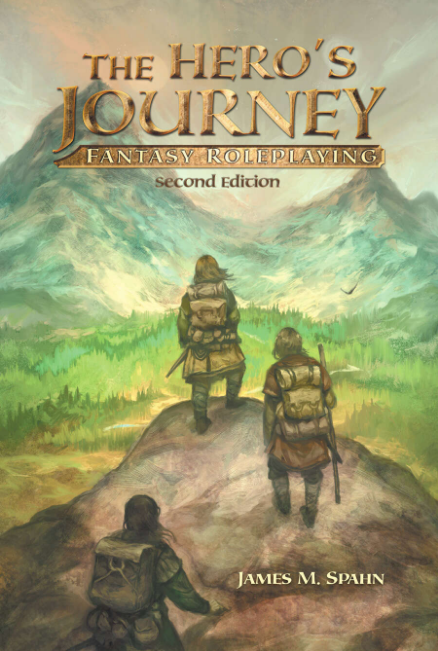The Hero’s Journey & Badgers
In the mail last week, I received James M. Spahn’s exceptional second edition of The Hero’s Journey (THJ hereafter) and the supplemental The Hero’s Grimoire. I’ve already received The Hero’s Journey Narrator’s Screen. I await with straining patience the arrival of The Hero’s Companion. I’ve read through the PDFs of the books, and I’m nothing other than pleased. Mr. Spahn’s latest offering to the gaming world stands as his best work to date. THJ ranks as the game I am most eager to play. (Nota Bene: The previous links are affiliate links.)

THJ has several Lineages (read: races), including the familiar dwarf, elf, half-elf, halfling, and human, and the somewhat unfamiliar changeling. The human lineage includes the errant variant human for those who might want to play, say, a teenager who rode of a plane-shifting roller coaster from the 20th century into a fantasy world.
The Companion book expands these to include the gnome, goblin, rover, scion, and skin-changer. The rover is an intelligent, plucky canine, almost certainly inspired by J. R. R. Tolkien’s enchanting Roverandom. I see further Tolkien influences with scions (humans descending from once-glorious noble families), skin-changers (towering humans who transform into bears), and tree folk. Attributes for a Lineage are determined by rolling one or more d6s, perhaps adding a modifier. Skin-changers roll 2d6+6 for Might and 1d6+2 for Bearing, compared to the elf’s 3d6 for Might and 2d6+6 for Bearing.
Each Lineage also may or may not qualify for certain Archetypes (read: character classes), and Lineage determines Archetype level limits. Thus, a dwarf can earn only six levels as a burglar, but a goblin can rise to tenth level. Each Lineage also includes several traits, somewhere between three to six of them, depending on Lineage. Changelings can See the Unseen, dwarves have an Artisan’s Eye, and Halfings move Silent and Unseen. Traits may impose limitations. A rover, being a plucky canine, cannot speak and doesn’t have fingers.
Good stuff.
For whatever reason, I cannot seem to disconnect THJ from the epic stories of Redwall by Brian Jacques and the classic The Wind in the Willows by Kenneth Grahame. I’ve read about half the Redwall series, including reading the title story more than once. I’ve read The Wind in the Willows several times as well. (Show me someone who does not love tales of plucky woodland heroes matching wits and muscles against nasty weasels, stoats, and rats, and you’ll be showing someone who probably can’t be trusted.) Thus, as much as I love Mr. Spahn’s treatment of standard fantasy races in THJ, I cannot help but think I ought to make up my own races drawing on the aforementioned books for inspiration.
I’ve taken a stab at this once before for 5E D&D. You can download those via this link. I don’t imagine repeating myself within the context of THJ should be all that difficult. For example, let’s take a stab at Badgers, with this picture acting as a visual muse. The miniature was painted by Michael Proctor, and the Frothy UK Badger is part of Dark Swords Miniatures fascinating catalog.
New Lineage: Badger
Large, strong, and driven by honor and duty, badgers rank among the greatest warriors. Badgers most often live in cavehomes or burrowhomes. Such as homes seldom have fewer than a half dozen entrances/exists, and most of these are hidden. Badgers are clannish and patriarchal. When a male badger nears adulthood, he leaves his home to find his way in the world.
Attributes: Might 2d6+6, Finesse 3d6, Resolve 2d6+6, Insight 2d6+1, Weal 3d6
Archetypes: Bard 4, Burglar 4, Knight 5, Ranger 5, Swordsman 7, Warrior 10, Wizard –, Yeoman 5
Born for Battle. Badgers learn to fight. They select two weapons (melee or ranged) that they may wield without penalty, regardless of any restrictions placed on them by Archetype.
Fearsome Bark. Badgers are the most fearsome of gentlebeasts. They have advantage on Saving Throws made to intimidate others, and their Bearing modifier for the Saving Throw is never less than +1.
Indomitable Courage. Badgers receive advantage on Saving Throws to resist all forms of fear, magical or mundane, including Despair.
Burrower. Badgers can burrow through earth with a movement rate of 1 regardless of the number of significant items carried. With cautious movement, the burrow is unlikely to collapse under normal conditions. With normal movement, the burrow is less stable, and burrows dug while running are unstable at best.
Dark Vision. Badgers can see in starlight, moonlight, or perfect darkness at a distance of up to 90 feet.

Leave a Reply